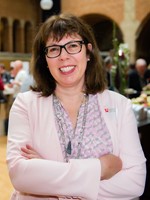

Making the Case for Design and Creativity in STEAM |
Listen and learn : Lecture
Sylvia Martinez
As many schools are working to incorporate STEM and STEAM into the classroom, design and creativity are the key to real and relevant learning experiences for all. Explore how design as the process of engineering opens the door for creative, technology-rich STEAM experiences.
| Audience: | Curriculum/district specialists, Principals/head teachers, Teachers |
| Skill level: | Beginner |
| Attendee devices: | Devices not needed |
| Topic: | Innovative learning environments |
| Grade level: | PK-12 |
| Subject area: | STEM/STEAM, Computer science |
| ISTE Standards: | For Coaches: Professional Development and Program Evaluation
Empowering Leader
Leader
|
Creativity is often misunderstood as simply a personal attribute – you are a creative person or you aren’t. Yet the word is crucial as schools struggle to implement STEAM programs that are defined only as subjects – not as mindsets. The “A” in STEAM is incredibly important – it is the verb of the sentence, and at its heart is the creative process. It is understood that artists have a creative process, but less well understood that scientists, engineers, and mathematicians do as well.
When schools work to understand what STEAM really means, there are certainly parts that seem easier than others. Most schools have math and science classes. Technology is taken care of as we increasingly adopt computers into classroom practices. Engineering is a small but growing option in many schools.
However, we have a long way to go. Science and math classes need to adopt modern ways that real scientists and mathematicians work. You can't just put a sign up that says "STEAM Academy" and think you are done. Students want and respond to science classes that are real and relevant, where they can engage in making things that make the world a better place, and in doing so, learn about the underlying laws of the world around them.
Technology is not only about computers, but about the basic human desire to change the world. Engineering is not just a college major, but a way for even young children to design and build things that help them make sense of the world.
When all of this is taken into consideration, you cannot help but notice that creativity, meaning literally to make things, is a key component. Design is the process of engineering and technology is the tool. Creativity is the mindset.
Recasting STEAM this way also invites more students who are not the "usual suspects" into the fantastic world of STEAM.
Outline = 5 min – STEM to STEAM - how this is a powerful lens to introduce design and creativity to STEM subjects
10 min – new technologies that support design and creativity in STEAM subjects
25 min – examples and connections to curriculum areas and standards
10 min – closing, questions
Invent To Learn: Making, Tinkering, and Engineering in the Classroom (author) http://inventtolearn.com
Play: How it Shapes the Brain, Opens the Imagination, and Invigorates the Soul – By Stuart Brown
Scientists Are More Creative Than You Might Imagine
https://www.theatlantic.com/education/archive/2014/11/the-creative-scientist/382633/
Engines of Innovation - Edward Glaeser
Science in Action: How to Follow Scientists and Engineers through Society - Bruno Latour
Thinking About Making – An examination of what we mean by making (MAKEing) these days. What gets made? Who makes? Why does making matter?https://vimeo.com/110616469
Recontextualizing the Makerspace: Culturally Responsive Education https://netarthud.wordpress.com/2014/08/29/recontextualizing-the-makerspace-culturally-responsive-education/
